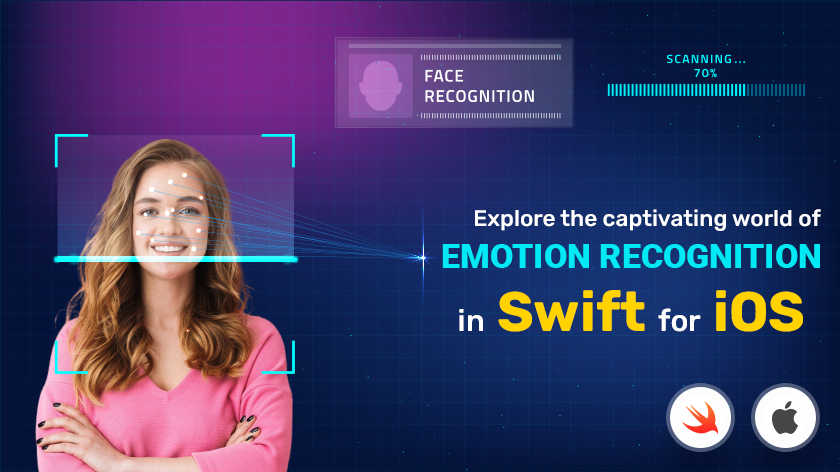In the bustling world of iOS app development, one of the most fascinating frontiers is emotion recognition. Imagine if your app could not only understand user input but also detect and respond to their emotions in real-time. This capability opens up a realm of possibilities for creating engaging and empathetic user experiences. In this blog, we’ll embark on a journey to explore the captivating world of emotion recognition in Swift for iOS.
Understanding Emotion Recognition:
Emotion recognition, a subset of computer vision and machine learning, involves analyzing facial expressions, voice tones, and other physiological signals to infer a person’s emotional state. In our case, we’ll focus on facial expression recognition, as it’s a widely researched and implemented area within the field.
The Tools at Our Disposal:
To dive into emotion recognition on iOS, we have a powerful arsenal of tools at our disposal:
- Swift: The primary programming language for iOS app development, known for its simplicity and expressiveness.
- Core ML: Apple’s Core Machine Learning framework, which allows developers to integrate machine learning models seamlessly into their iOS apps.
- Vision Framework: This framework provides high-level functions for performing tasks like face detection and facial landmark tracking, essential for emotion recognition.
- Pre-trained Models: Numerous pre-trained machine learning models are available for emotion recognition, ranging from simple classifiers to sophisticated deep neural networks.
Building Our Emotion Recognition App:
Now, let’s roll up our sleeves and dive into the process of building an emotion recognition app in Swift for iOS.
- Setting Up the Project: Create a new Xcode project using Swift as the primary language.
- Integrating Core ML: Import the Core ML framework into our project and add a pre-trained emotion recognition model. You can either train your own model or leverage existing ones trained on vast datasets of facial expressions.
- Face Detection: Utilize the Vision framework to detect faces in images or video streams. This step is crucial as it provides the input for our emotion recognition model.
- Processing Facial Expressions: Once faces are detected, extract facial landmarks such as the position of the eyes, nose, and mouth. These landmarks serve as the input features for our emotion recognition model.
- Emotion Inference: Pass the extracted facial landmarks through our pre-trained emotion recognition model to predict the emotional state of the user. Common emotions include happiness, sadness, anger, surprise, fear, and neutrality.
- Feedback and Interaction: Based on the inferred emotion, tailor the app’s response to create a more personalized and empathetic user experience. For example, a wellness app could offer comforting messages for users detected as sad, while a gaming app could adjust difficulty levels based on the user’s level of engagement.
Challenges and Considerations:
While emotion recognition holds tremendous potential, it’s essential to be mindful of certain challenges and considerations:
- Privacy and Ethical Concerns: Emotion recognition involves processing sensitive user data, raising concerns about privacy and ethical implications. It’s crucial to handle user data responsibly and transparently, ensuring compliance with relevant regulations such as GDPR.
- Accuracy and Robustness: Emotion recognition algorithms may not always be accurate, especially in real-world scenarios with varying lighting conditions, facial expressions, and demographics. Continuously refine and evaluate your model to improve accuracy and robustness.
- Cultural Sensitivity: Emotions can manifest differently across cultures, making it essential to consider cultural nuances when designing emotion recognition systems for a global audience.
Conclusion:
In conclusion, the world of emotion recognition in Swift for iOS is both captivating and full of potential. By leveraging the power of machine learning, computer vision, and empathetic design principles, we can create iOS apps that not only understand user input but also empathize with their emotions. Whether it’s a wellness app offering support during difficult times or a game adapting to the player’s mood, emotion recognition opens up exciting opportunities to create more engaging and human-centered experiences in the iOS ecosystem.
As we continue to explore and innovate in this field, let’s keep empathy and user well-being at the forefront of our endeavors, ensuring that our technology enhances the human experience rather than diminishes it.
Happy coding, and may your apps bring joy and comfort to users around the world!
I’m Part of XcelTec, a Leading iOS App Development Company! XcelTec is a specialize in creating cutting-edge iOS apps using Swift and Xcode technologies. If you’re interested in developing an iOS app that harnesses the latest advancements in emotion recognition and beyond, you’re in the right place.
Contact us now to bring your vision to Reality!
Visit us now: https://www.xceltec.com/

